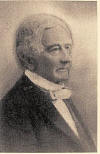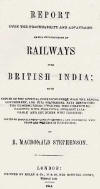
|
|
|
Lord Dalhousie |
Railways
arrived in India within 30 years of their inauguration in England. Lord
Dalhousie foresaw the tremendous
potential for this modern, speedy means of transport in securing British control
over a vast country with large sections of rebellious population. He had a dream
of
‘binding India by iron
chains’
primarily
with an aim of increased facilities to be derived from railway transport in the
administration of the country and the mobility of military and other security
forces and to transport Indian cotton for English textile mills.
The initial
crucial discussions in connection with the commencement of the railway
construction were started by the sponsors of the East Indian Railway Company
formed and organized in May , 1845.
Rowland McDonald Stephenson, the first Agent and Managing Director of the East Indian Railway Company was the pioneer for ushering in the railways into India, particularly Eastern India. In 1844, he submitted the first traffic and engineering feasibility report for a line from Calcutta to Mirzapore to the East India Company.
In May 1845, Stephenson established the East Indian Railway Company with a membership drawn mostly from England and worked relentlessly to get the East India’s Company’s approval. When William Theobold, a friend of R. M. Stephenson approached Prince Dwarkanath Tagore, he offered to raise one third of the capital for a line connecting Calcutta and the Burdwan collieries.
|
R.M.Stephenson's report |
After four years
of protracted negotiations and strenuous efforts, including a direct appeal to
the British Prime Minister, a contract was signed on 17th August 1849
between East Indian Railway Company and the East India Company, entitling the
former to construct and operate an “experimental” line, 161 kms. long between
Calcutta and Rajmahal which would later be extended to Delhi
via Mirzapore.
There were
objections in India too. One British Engineer felt that it was impossible to lay
a railway line on the surface of the land in India, on account of high
mountains, impassable mountains, thick jungles, herds of cattle etc.
He
recommended that the line be suspended throughout its length by suspension
chains at a minimum height of eight feet above the ground!




